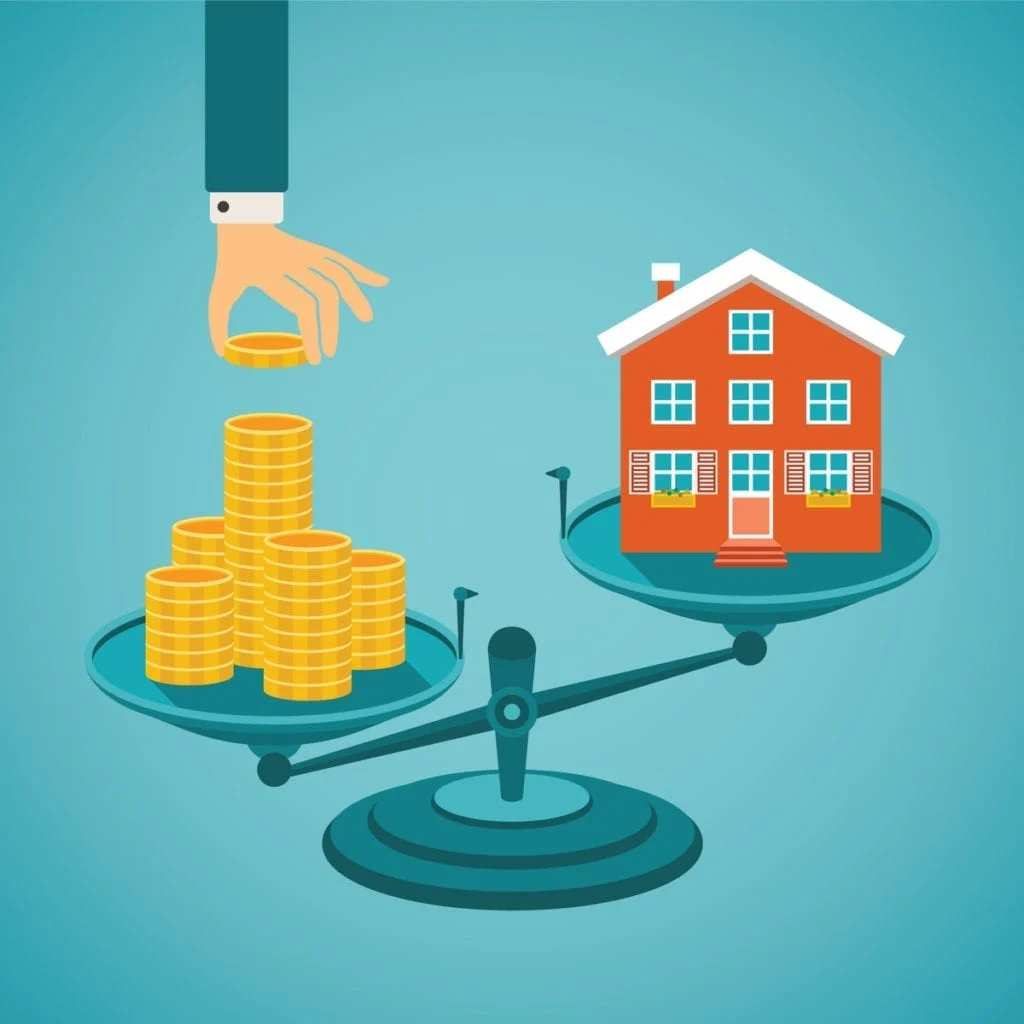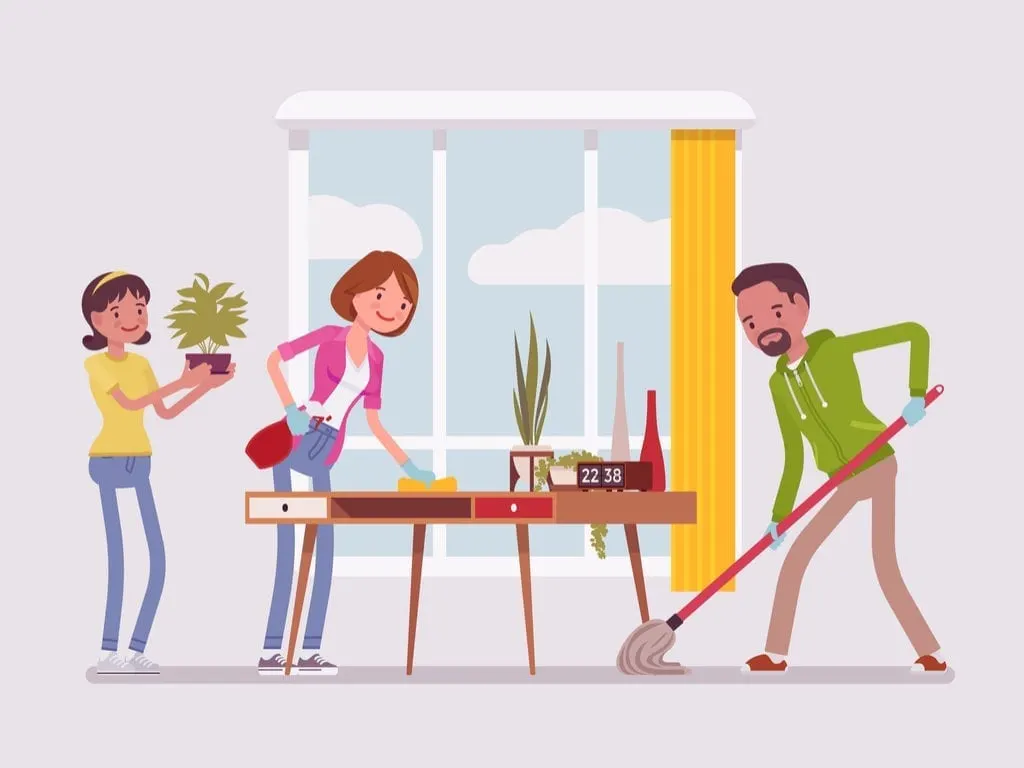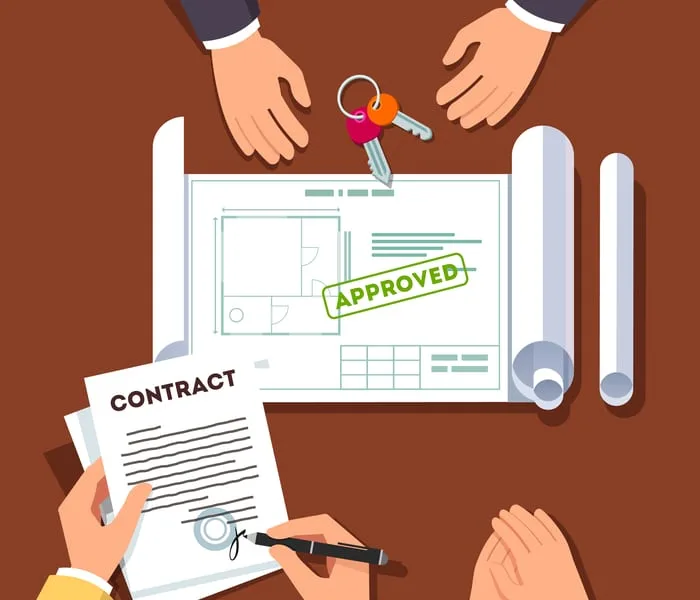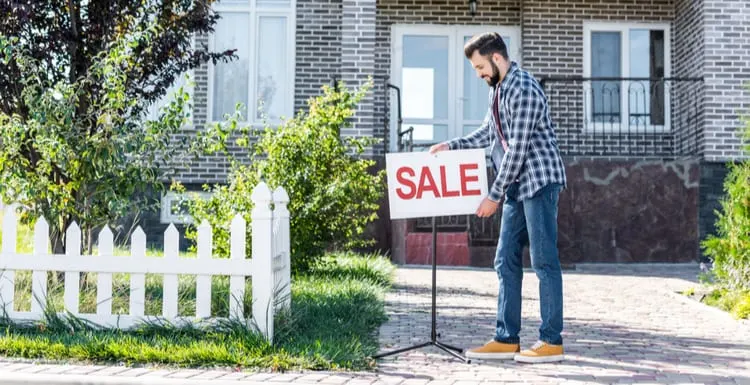Are you wondering how to sell your house? If so, you’re in the right place.
Our complete guide walks you through the steps, timeline, and more. Read on to learn everything you need to know.
How to Sell Your House in 2024
Selling a house requires hard work and time. The journey can be difficult, and you might feel frustrated if you can’t find a buyer who agrees to your terms. But when you do finally sell it, you will feel great.
While this process can be stressful, we’ve created a guide that details everything you need to know about how to sell your home. Read on for tips, tricks, and a step-by-step guide to make things a little easier.
1. Decide Your Intentions

Fahmidesign/Shutterstock
The first thing you must decide is how you plan to sell your home. The reason for selling dictates other aspects of the process. This includes the strategy used, the required preparations, and the cost of selling your home.
Before the digital age, sellers had no option but to list their homes with a realtor. This has changed, and you now have many ways to sell.
When deciding which option to choose, you should weigh the pros and cons of each to determine the one that works best for you. After all, there are countless ways to do so in the digital age.
Real Estate Agents
Real estate agents market your home, prepare the paperwork, and communicate with the buyer’s agent. Many sellers prefer working with an agent to guide them on pricing, market expectations, and incentives.
This helps them sell their home quickly and without fuss. The biggest benefit of using an agent is that they provide guidance throughout the sale process. Sellers can’t access the MLS, so it’s harder to find comparable sales data.
Additionally, MLS access allows realtors to list the property for other agents to see. While you can still use sites like Zillow, the MLS is a great tool for home sales as it helps cast your marketing net as wide as possible.
Of course, there’s a cost to using a real estate agent. Sales commissions are typically between 5% and 7% of the total sale price, and it’s standard for the seller to pay this fee. If your home sells for $200,000 and your rate is 7%, you’ll pay $14,000 in commissions.
For Sale by Owner (FSBO)
With the FSBO option, you are required to manage every aspect of the sale. Since you are listing the home yourself, you won’t have to pay an agent’s commission. In these kinds of transactions, you have an asking price you’ll stick to, and the buyer pays their agent commission.
If your home’s condition is good, you will receive better offers, and it will be easier for you to justify your asking price. While FSBO does save you money, it requires more time and effort.
All the marketing and paperwork fall under your know-how. You will need to take care of all tasks, including listing your property online, taking photos, and scheduling showings. You must also have local market knowledge to accurately price your home.
Many homeowners don’t use FSBO, as saving money on the agent’s commission isn’t worth their extra efforts. Want more information? We’ve taken the headache out of this process by creating a competitive guide for FSBO homes.
2. Determine Your Asking Price

Alex Oakenman/Shutterstock
In order to effectively price your home, you must consider your personal expectations as well as the market conditions. If your home is overpriced, you won’t get offers from buyers for weeks or even months.
There are different online tools that you can use to estimate the value of your home. You can also value your home by selecting some comparable homes that have been sold recently in your area.
It is difficult to find an exact match, so you (or your agent) will need to make some adjustments. For example, say there are four bedrooms in your home while the comparable home has three.
How much would that home be priced for if it had four bedrooms? This gets even harder when homes have amenities like a pool or mountain view. Once you have determined the value of your home, consider whether time or money is more important to you.
If you need to sell your home quickly, you can consider pricing your home competitively. However, if you can wait for a few weeks or months, consider going with a higher price.
3. Prepare Your Home for Market

Andrew Rybalkp/Shutterstock
The better the condition of your home, the more offers you’ll receive, and it will be easier to justify your asking price.
Follow these steps to get your home in good condition and increase its curb appeal before an open house and showings:
Maintenance
Assess wear and tear on your home and address flaws that could lower the appeal of your home and its sales price. Take a look around to determine how much improvement is needed and where your home needs fixing.
You can handle things like updating lighting, sprucing up the yard, adding a fresh coat of paint, and replacing doorknobs. Other problems that are more significant may require hiring a home maintenance company.
Issues related to heating, ventilation, air conditioning, plumbing, water damage, water heaters, mold, roofs, and foundations can all prove to be deal-breakers if you don’t address them before showings.
Declutter
When preparing your home for sale, consider decluttering to make it look clean and spacious. Consider how your home will look from a potential buyer’s perspective.
Does it feel welcoming? Clear the shelves, corners, closets, and countertops to make your space look clean. The goal is to make it move-in-ready.
Décor
Decorate your home to make it look more appealing to prospective buyers. However, don’t use overpowering colors or add funky accessories to the walls. Instead, add subtle decorations to create a welcoming environment.
Order an Inspection
Many home buyers order a home inspection before buying. But it’s a great tool for sellers too. It does cost you money, but it’s worth it because it can prevent buyers from negotiating beyond the rightful value of your home.
A home inspection covers the foundation, basement, structural elements, attic, roof, visible insulation, windows, ceilings, doors, floors, walls, plumbing, electrical, cooling, and heating systems.
A qualified home inspector assesses the condition of your home and checks for any health and safety problems. Once they have completed the inspection, you will get a detailed report that shows what works and what needs fixing.
The report will also include recommendations for repairs and maintenance work. If you get your home inspected after performing the maintenance work, there won’t be major issues in the report.
If there are still any big-ticket issues that need to be fixed, address them before showings, as they may allow buyers to negotiate big bucks since they will have to do the fixing themselves.
Related: Many sellers buy home warranties to include in the sale. These give buyers peace of mind that if something breaks, it’ll likely be covered.
4. Create a Compelling Listing

Vladwel/Shutterstock
The home listing is the first thing people see. If you have a good listing, chances are that buyers will be more attracted to your home. Conversely, a bad listing will turn otherwise interested buyers away.
In fact, this is one of the most important steps in our home selling guide. Here are a few tips to help you avoid making simple mistakes:
Listing Data
When listing your home, you will need to provide information like the year built, lot size, number of bedrooms and bathrooms, and other important details like parking arrangements.
Description
Write an appealing description to capture the attention of potential home buyers. Brainstorm the points that will appeal to them, and try to see your house through potential buyers’ eyes.
Don’t write a description that’s too lengthy; focus on the most important selling points of your home. If you struggle, read descriptions of other listed homes in your area.
Photos
You don’t have to shell out hundreds of dollars to hire a professional photographer to take stellar photos of your home. However, you should do your best to take high-quality photos.
Consider getting help from family or friends who know a thing or two about photography. They might be able to take close-in shots and use lighting tricks to make the photos of your home look more appealing.
But a good real estate photographer is not easy to find. Fortunately, you’re in the digital age, and companies like Stilio make it easier than ever to connect with a pro.
Tip: Visit your local community college. Most schools have photography departments with students looking to cut their teeth with real-world experience.
5. List And Market Your Home

Venimo/Shutterstock
The next step in our guide on how to sell your house is to market it. After all, the preparation is done for a reason.
These options vary based on whether you’ve hired a realtor, but we’ve included all of them in our all-inclusive guide.
Use the MLS
If you are working with a real estate agent, they will both market your home and list it on the MLS.
They are responsible for taking professional photographs, posting “home for sale” signage in your yard, and doing other things to market your home.
If you choose to sell the home yourself, you will take care of all these things on your own.
You will enter your home into the MLS database so that buyers can find it. Since you are listing without a real estate agent, you will have to pay a flat fee to list your home in the system.
List on FSBO Sites
You should list your home on FSBO sites if you aren’t working with a real estate agent. On FSBO.com, the cost of the FSBO.com-only listing package is around $100 for six months.
The Realtor.com and MLS packages cost around $400 for six months, and these include syndication on Trulia and Zillow.
Real Estate Websites
If you don’t want to pay a hefty fee for FSBO packages, consider posting your home listing on Zillow, Trulia, and other real estate sites. These sites don’t charge anything for posting home listings.
Yard Signs
Perhaps the most overlooked marketing method is the old-fashioned yard sign. These capture the attention of anyone traveling by the house and will generate word-of-mouth interest from neighbors and their friends.
6. Conduct an Open House

Kraska/Shutterstock
After you have listed your home on the market, it’s time for the open house. These help generate market interest and attract walk-in traffic. If you are working with an agent, they’ll handle this, so you can skip ahead to Step 9.
Schedule your open house at a time that would be suitable for both you and the visitors, like a weekend or evening. A typical open house lasts for two to three hours, but you can extend it if you want to.
If you do everything we have discussed above, your home will be clean and ready. All you have to do is spread the word. Consider putting up ads on Nextdoor and other websites that are popular among home buyers.
Also, post details about your open house on social media platforms and ask your friends and family members to promote it. You can also post flyers in the area around town to attract more interested buyers.
Be present to entertain visitors during your open house. Devote your attention to visitors, even if they don’t appear to be serious about buying your home. Answer their questions thoroughly, and don’t try to hide anything.
The goal of the open house is to let everyone know that you are selling your home and make a good first impression of your property.
People who visit your home may tell others about it, which means that you will be getting more offers after an open house.
Tip: Maximize the impact of your open house by using open house sign in sheets.
7. Show Your Home

Zentangle/Shutterstock
If your home is marketed well and priced right, you’ll get calls or emails from interested buyers asking you to show it. Showing is an important part of the home-selling process and not one to be taken lightly.
After all, this is the time to let your sales skills shine (but make sure not to oversell). When showing your home, make sure it’s clean and pets are put away or even taken off the property.
This way, potential buyers can look around without distraction. Many home sellers will hide family photos and deep-clean the whole house. You might want to consider even having the home staged by a professional company.
8. Review Offers and Negotiate

Tynyuk/Shutterstock
Once a buyer likes your home, they will make a written offer. This will be submitted to the agent or buyer (if listing FSBO). When an agent submits an offer, they frequently use a National Association of Realtors-prepared form.
This step is crucial to ensuring you get the best value for your home, so analyze it with a fine-tooth comb. In addition to the offer price, you should consider:
Is the Buyer Pre-Approved?
Check whether the buyer who is making an offer is pre-approved. Pre-approval shows that the buyer is eligible for financing, which means you have a good chance of the deal closing.
Closing Costs
Home buyers may ask you to provide closing assistance. This is a specific amount that must be paid at closing and assists the buyer with closing fees. These costs are usually minimal.
Seller Concessions
These are additional financial incentives that you may provide to the home buyer. Seller concessions may include money for things like title insurance or homeowner association fees.
It also includes origination fees and appraisal or inspection fees. In a seller’s market, offers typically cover part of the seller’s closing costs to make the offer more attractive.
Buyer’s Contingency
Buyer’s contingency is a specific clause in the home sale contract that states that the home buyer can buy the home only after they have sold their current property. You may accept the offer with this clause.
However, if you receive multiple offers and want to sell your house fast, it would be better to accept offers without a buyer’s contingency. Otherwise, you won’t be able to sell your home until the buyer has sold theirs.
Disclose, Disclose, Disclose
When you are selling a home, it’s your obligation to disclose any potential problems with your home. Has the basement ever leaked? Tell the buyer.
Is the roof old? Tell the buyer. Is there a crack in the foundation? Tell the buyer. You get the idea—the more disclosure, the better. Ultimately, this helps protect you from any future lawsuits.
9. Accept an Offer and Seal the Deal

Vladwel/Shutterstock
Once you accept an offer, your home will be taken off the market. The buyer will inspect the home once again to ensure that they are ready to purchase it.
After they have done their due diligence, the home buyer will obtain a mortgage for their new home; this is called the underwriting period.
The bank or lender will assess the buyer’s financial situation and the home they intend to purchase during the underwriting phase to make sure they are a good candidate for the home loan.
10. Sign Your Title and Escrow

Iconic Bestiary/Shutterstock
The last step of the home-selling process is signing the title and escrow documents. A real estate attorney will generally oversee the closing process. Make sure to take a valid photo ID with you when you go to sign these documents.
After you have signed, the seller will become the new owner of your home. Your money will be wired, and the sale of your home will be complete. Make sure the title company has a closing date scheduled early in the process.
Tip: You have a few options for moving your belongings. You can hire movers or rent a truck to drive yourself.
So, Are You Ready to Sell Your Home?
Well, that’s it! We’ve told you how to sell your house, and we hope our complete guide has been helpful.
While you’re on our site, make sure to check out our other resources for both buyers and sellers, as well as homeowners.

